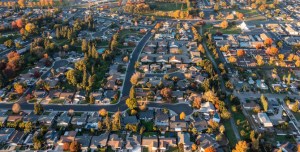Scott W. Allard, the Daniel J. Evans Endowed Professor of Social Policy at the Evans School of Public Policy & Governance at the University of Washington1, is a visiting scholar with the SF Fed’s Community Development team and has written extensively about poverty and employment issues in America. Dr. Allard recently sat down with Elizabeth Kneebone, assistant vice president of community development research at the SF Fed, to discuss a research collaboration they are undertaking, along with Natalie Holmes2 and Julia Karon3, to examine the changing nature of job access for low-income workers and communities across the United States.
Elizabeth Kneebone: Scott, each of us has spent considerable time researching the many ways in which places shape access to opportunity. Living in a community or metropolitan area that provides “access to opportunity” can mean a lot of things, including the ability to find affordable housing, quality child care and education options, or transportation networks that enable individuals to participate in the economy. Especially when thinking about increasing economic participation and upward mobility for low-income workers, where a person lives matters because it affects the number, type, and quality of jobs they have access to.
Scott Allard: That’s right. Job access—specifically geographic proximity to employment opportunity—is an important dimension for understanding employment outcomes and mobility, because it affects one’s likelihood of employment, hours worked, rate of pay and earnings, and the childcare or transportation costs of going to work.4 Being farther from or closer to work also has implications for work-life balance and happiness.5 And evidence suggests job proximity is particularly important for lower-income workers who face more constraints in terms of where they can afford to live and how much they can spend on commuting.6
Elizabeth: Even before the pandemic, you and I were talking about the importance of continuing to explore patterns and implications of job access and how—and where and for whom—they might be changing. It feels like the pandemic only increased the timeliness of these questions. The research evidence accumulated over the decades underscores the importance of the relationship between where someone lives and where they work, but that landscape has likely been shifting.
Scott: It likely has. Research examining job access in the 1980s and 90s focused on how patterns of suburban job growth, declining job location in cities, and racial residential segregation in urban centers changed where jobs were located relative to jobseekers. In that era, it was commonplace for models of work and commuting to focus on a particular form of spatial mismatch, where a gap in job access existed between residents of job-rich suburban areas and residents—particularly residents of color—in central cities where there were comparatively fewer jobs. Indeed, there was substantial evidence by 2000 of spatial mismatches in labor markets that led to significant disparities in job access by race and ethnicity.7 Fast-forward to today, and there is evidence of broader shifts in metropolitan areas that may affect job access. For one, the continued suburbanization of the American population now means that a plurality of workers—including low-wage workers—live in suburbs, rather than cities. Suburban areas are more diverse in terms of class, race, and ethnicity than ever before in American history, and the pandemic only continued ongoing trends in the suburbanization of the population living below the poverty line.8
Elizabeth: There have also been numerous labor market developments over the past decade that suggest shifts may have occurred in the spatial organization of work life and home life in metropolitan America, at least for some populations. Employment continued to suburbanize in the 2000s, and, coupled with the economic disruptions of the Great Recession, there is evidence that proximity to employment worsened, particularly for low-income workers and people of color.9 But how are those populations faring after the ups and downs of the subsequent economic expansion and COVID-19 crisis that ended it? What is more, the pandemic also led to a decoupling of where one lives and where one works, at least for some households.10 And it accelerated the rising trend of remote work: more people are working from home today than was the case in 2019.11 The nature of work itself has also been shifting due to continued automation within certain labor market sectors and the advent of AI and Generative AI tools, and it remains unclear what impacts those shifts will have on different regional economies and their lower-income workers.12
Scott: Despite these many changes, we often approach the relationship between residential location and workplace location as if labor markets still operated consistent with the conventional spatial mismatch hypothesis. Instead, there is ample reason to reexamine patterns of job accessibility in light of the demographic and labor market shifts in recent years.
Elizabeth: While past patterns of job access and mismatch likely persist to some degree, so much has changed that through this research partnership we are motivated to ask a number of questions to better understand the connection between place of residence and place of work post-pandemic: Has the spatial organization of work and home life changed appreciably in the largest metro areas? Are workers more likely to live in or move to areas with greater access to employment opportunity today than 10 years ago? What do we know about whether workers are living closer to or farther from their jobs in terms of distance or travel time? Has remote work become a more permanent component of metropolitan labor markets, or is it fading back to pre-pandemic levels? And, do any changes in the spatial arrangement of work and home operate similarly for different types of workers?
Scott: Understanding the degree to which job access and proximity have changed in the last decade is also more than just a simple academic calculation. Answers to these questions are important for understanding contemporary metropolitan labor markets and, in turn, to informing a host of workforce, transportation, and human service responses. This is particularly true when we think about providing low-income households with pathways to greater economic and social mobility. As metropolitan areas, counties, and cities continue to invest in housing, transportation, and early childhood education services, it becomes important to know how the spatial relationship between home and work has changed—and particularly for whom and where it has changed. I am excited about what we might learn through this collaboration and how that might help inform efforts to reduce persistent disparities in employment and earnings for low-income workers and workers of color.
Footnotes
1. Scott W. Allard, Associate Dean for Research & Engagement and Daniel J. Evans Endowed Professor of Social Policy, Evans School of Public Policy and Governance, University of Washington
2. Natalie Holmes, PhD student, Goldman School of Public Policy, University of California, Berkeley
3. Julia Karon, PhD student, Evans School of Public Policy & Governance, University of Washington
4. Job Displacement and the Duration of Joblessness: The Role of Spatial Mismatch
5. Travel Time and Subjective Well-Being
6. Proximity and Opportunity: How Residence and Race Affect the Employment of Welfare Recipients
7. The Spatial Mismatch between Jobs and Residential Locations within Urban Areas; Within Cities and Suburbs: Racial Residential Concentration and the Spatial Distribution of Employment Opportunities across Sub‐metropolitan Areas
8. Today’s Suburbs are Symbolic of America’s Rising Diversity: A 2020 Census Portrait
9. Job Sprawl Revisited: The Changing Geography of Metropolitan Employment; The Growing Distance between People and Jobs in Metropolitan America; The Decline in Access to Jobs and the Location of Employment Growth in US Metro Areas: Implications for Economic Opportunity and Mobility
10. COVID-19 Pandemic Continues to Reshape Work in America
11. In U.S., Telecommuting for Work Climbs to 37%; Working from Home: Before and After the Pandemic
12. Which U.S. Workers are more Exposed to AI on their Jobs?
The views expressed here do not necessarily reflect the views of the management of the Federal Reserve Bank of San Francisco or of the Board of Governors of the Federal Reserve System.




